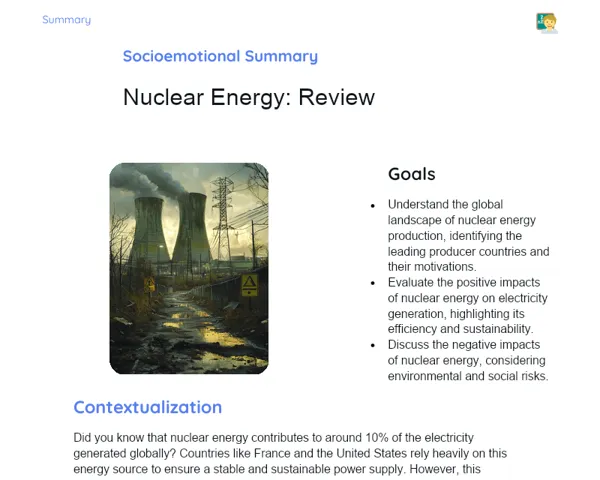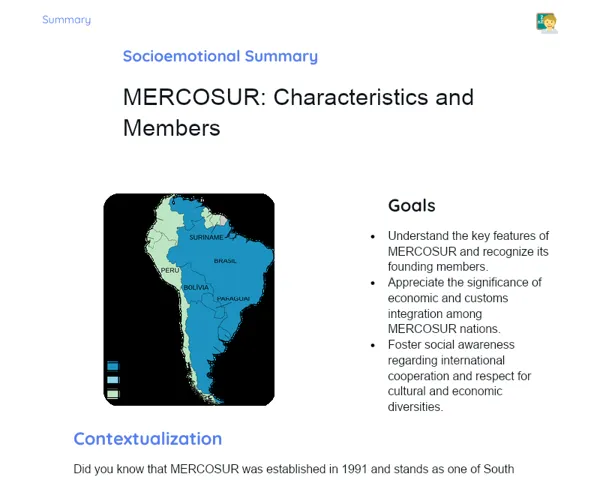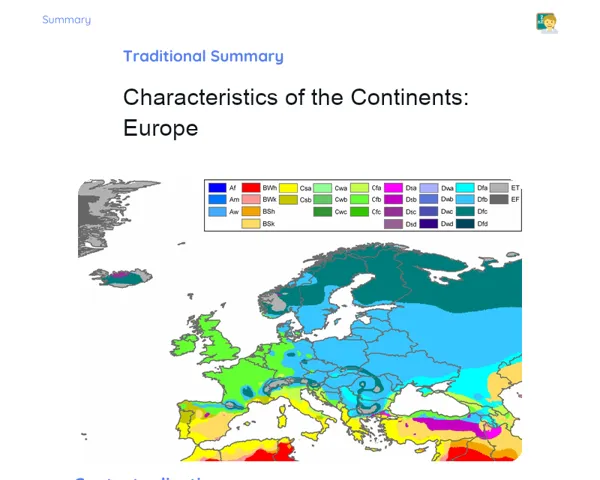Socioemotional Summary Conclusion
Goals
1. Identify and understand the characteristics of igneous, sedimentary, and metamorphic rocks.
2. Learn how different rock formations shape the landscapes around us.
3. Cultivate self-awareness and emotional regulation by connecting our feelings to the study of rocks.
Contextualization
Did you know that rocks can narrate the history of our planet and its changes over time? Just as we encounter obstacles and transitions in life, rocks undergo fascinating transformations, from the cooling of magma to sediment compaction and metamorphosis under pressure. Let’s delve into these extraordinary formations together and see how they influence landscapes and our emotional strength!
Exercising Your Knowledge
Igneous Rocks
Igneous rocks are created from the cooling and solidification of magma, the hot molten material beneath the Earth’s crust. They can be split into intrusive types, which form underground, and extrusive types, which solidify on the surface. Each kind of igneous rock holds clues about how it was formed, helping us read the geological narrative of our planet.
-
Intrusive Rocks: These rocks form deep within the Earth, like granite, and cool slowly, allowing large crystals to develop.
-
Extrusive Rocks: Formed on the surface, like basalt—they cool quickly, leading to smaller crystals.
-
Mineral Composition: The variety of minerals in igneous rocks reveals their formation and potential economic uses.
Sedimentary Rocks
Sedimentary rocks form through the gradual compaction and cementation of sediments over time. These sediments can include bits of other rocks, minerals, and even the remains of living beings. As a result, these rocks often hold fossils, providing a vital record of life and environmental shifts over the ages.
-
Formation by Compaction: Over time, sediments compress to become rocks like sandstone.
-
Cementation: Minerals dissolved in water act as a ‘cement’ to bind the sediments, resulting in rocks such as limestone.
-
Presence of Fossils: Sedimentary rocks can contain fossils that help us piece together the history of life on Earth.
Metamorphic Rocks
Metamorphic rocks arise when existing rocks transform under extreme pressure and temperature, without melting. This transformation process, called metamorphism, changes the structure and mineral content of the original rock, giving it new features. Just like we grow from our experiences and challenges, these rocks undergo a 'metamorphosis' reflecting the geological forces they face.
-
Transformation: The original rock, or protolith, changes through pressure and temperature, leading to new types like marble (from limestone) and slate (from shale).
-
Foliated Texture: Some metamorphic rocks display a layered structure due to mineral alignment under pressure.
-
Geological Importance: Examining metamorphic rocks allows scientists to deduce past geological conditions.
Key Terms
-
Igneous Rocks: Formed from cooling magma.
-
Sedimentary Rocks: Created through sediment compaction and cementation.
-
Metamorphic Rocks: Altered from other rocks by heat and pressure.
-
Magma: Molten material below the Earth’s surface.
-
Compaction: Compressing sediments to create sedimentary rocks.
-
Cementation: Dissolved minerals bind sediments together.
-
Metamorphism: The transformation of rocks under pressure and heat.
For Reflection
-
What emotional challenges have you encountered that reflect the transformation of a metamorphic rock?
-
In what ways can the different stages of rock formation teach us about our ability to adapt and be resilient?
-
How does studying rocks and their formations enhance your understanding of overcoming personal and academic hurdles?
Important Conclusions
-
Igneous rocks are formed from magma, which can be either intrusive or extrusive, each with unique features that help us comprehend the geological history of the Earth.
-
Sedimentary rocks arise from the compaction and cementation of sediments, often containing fossils which are crucial in recording changes in life and the environment over time.
-
Metamorphic rocks illustrate the impact of pressure and temperature on rocks, symbolizing how life challenges can transform and fortify us.
-
Grasping the features of various rock formations enriches our understanding of our environment and offers insights into our own resilience and adaptability.
Impacts on Society
Knowledge of rock characteristics plays a vital role across various sectors in society. In construction, selecting the right type of rock is crucial to ensure building safety and longevity. In the mining industry, understanding rock formations can indicate the presence of valuable minerals, affecting the global economy. On a personal level, appreciating the geology around us fosters a deeper connection to nature and highlights the importance of environmental conservation. The knowledge that rocks can house fossils connects us with Earth’s past, raising our awareness towards sustainability and the imperative to protect our planet for future generations.
Dealing with Emotions
Using the RULER approach, I suggest creating an emotional journal reflecting on your rock studies. Firstly, acknowledge and jot down your emotions while learning about each rock type. Next, try to comprehend what triggered these feelings and their implications. Make sure to accurately label these emotions and express them in your journal—whether through writing, sketches, or another form you prefer. Finally, strategize ways to manage these emotions, particularly if you experience frustration or difficulty, and reflect on how you might handle such situations better in the future.
Study Tips
-
Create flashcards highlighting the key characteristics of each rock type and review them regularly to reinforce your learning.
-
Watch documentaries or educational videos about geology for practical and visual learning of rock formations.
-
Form study groups with classmates to discuss topics and exchange knowledge, using emotional analogies to enhance understanding.



